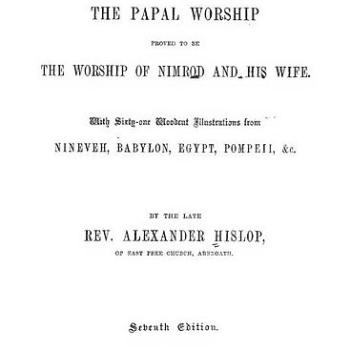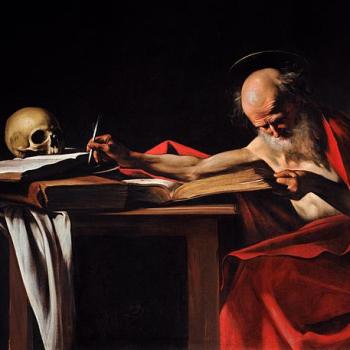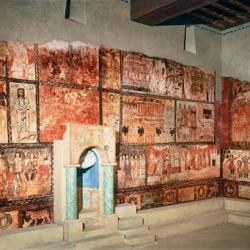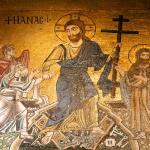
[words of anti-Catholics “Turretinfan” will be in blue; Ken Temple’s in green; Ron DiGiacomo’s in purple]
Turretinfan recently wrote:
Men love idols. We can see this throughout the Old Testament and New Testament. . . . The Israelites are repeatedly warned against the dangers of idolatry . . . The New Testament likewise describes the pagan fondness for idolatry . . . It’s a huge temptation, and the religion of Rome is rife with it. For example, the bread and wine are worshiped as though they are God . . . It seems reasonable to conclude that people who join Rome, join it because they love its idolatry. They are not filled with a righteous indignation at this abominable practice, but instead find it alluring.
Baptist missionary pastor and fellow anti-Catholic Ken Temple concurred in the combox: “I think you are right on in that men love their idols, but they would never admit that is idolatry. They are deceived.”
Ken also wrote at the notorious anti-Catholic Boors All forum:
[T]he sinful heart of humans, as Calvin said, “is an idol factory”, . . . the sinful heart of man loves idols and clings to them, but the man is deceived and thinks, “I am not an idolater”, but in reality they are. . . . They want something they can control. Aaron said to the children of Israel, “behold (the golden calf) this is your god, who brought you up from the land of Egypt” (you can see and touch and feel him now) . . . being able to feel and touch and see the relics and statues and icons and other “devotional helps” is really idolatry; but the RC or former Protestant doesn’t see it; he or she is deceived. Officially, they say “no”; but in reality, they are involved in idolatry with worshiping the bread and wine and prayers to Mary, etc.
Idolatry in its scope goes far beyond appearances and physical things as well. This is the very fact that the anti-Catholics don’t grasp, even though it is made crystal-clear in the Bible. There are many idols that are immaterial: greed, pride, self-importance, desire for power or fame, etc. Anything that replaces God is an idol.
The incarnation explicitly associates God with a physical thing: human flesh. That is the heart and origin of the sacramentalism that developed as a result of it. But God didn’t completely dissociate Himself from the physical even in the Old Testament. There were still many theophanies where He took on the appearance of a man (Gen 18:1-4, 13, 17, 22; Ex 24:10-11; Jud 6:12-23; 13:21-22; Josh 5:14-15).
When He appeared in the pillars of fire and smoke (Ex 13:21-22), the burning bush (Ex 3:2-6, 14, 16), the cloud and fire of Mt. Sinai (Ex 24:16-18), and the Shekinah glory cloud (Ex 40:34-38), those things were physical. He also said that people couldn’t see His face, but could see His “back” (Ex 33:23 [RSV]: “then I will take away my hand, and you shall see my back; but my face shall not be seen.”).
So it wasn’t absolute. Jacob wrestled with “a man” and then the “man” said: “you have striven with God and with men, and have prevailed.” Afterwards, Jacob stated: “I have seen God face to face, and yet my life is preserved.” This is all before the incarnation: quite physical manifestations of God (Gen 32:24-30). Then in Genesis 35:9 it says that “God appeared [not just spoke] to Jacob again . . .”
Thus, the anti-Catholics are dead-wrong about God and the physical, too. Nor were all physical things forbidden even in the context of worship, since the Jews bowed before the ark of the covenant or the temple when they prayed. This is use of a physical image in the context of worship and prayer. And God was particularly present in proximity to physical objects: the mercy seat on the ark in the holy of holies in the tabernacle or temple, and the holy mountain, etc.
Turretinfan then chimed in with another astonishingly clueless remark (i.e., for someone supposedly so acquainted with the Bible, and therefore, presumably what it teaches about the definition of idolatry):
A. Is what they do idolatry?
B. Do they love what they do?
And also again:
Moreover, they clearly ascribe divinity to and worship as God the bread in the Eucharist (first commandment idolatry). . . . if they really loathed the idolatry of the mass, they wouldn’t go to mass.
And again (now asking fellow Calvinist — but not fellow anti-Catholic — “Pilgrimsarbour” questions):
So, let me ask you this more narrowly:
A. Is it the sin of idolatry to worship a piece of bread as though it is God?
B. Do Romanists do that?
I have refuted the idolatry argument before, many times. Here is my argument in a nutshell (and I think it is a very strong, in fact, compelling one):
1) Idolatry is by definition an internal phenomenon: God has been replaced with something else in one’s heart and allegiance.
2) Catholics are not replacing God with anything else at the Mass, since we believe that the bread and wine are no longer there.
3) We are worshiping God at Mass, not bread and wine, by the very definition of transubstantiation (itself a doctrine so maligned and despised by many non-Catholic Christians).
4) If anyone (I speak rhetorically) is confusing bread and wine with God, it is Lutheranism, since they think that both are literally present together after consecration. But they, too, would say they worship God, not bread and wine, and thus, are unfairly accused of idolatry (though Calvin accused Luther and Lutherans of precisely that).
Turretinfan and Ken want to have it both ways. It’s a sleight-of-hand, and intellectually dishonest (as a result of their anti-Catholic bias, of course). Martin Luther is not accused of idolatry by these guys (even though their hero Calvin accused him of it) for believing in the Real Presence (consubstantiation). Only Catholics receive this criticism. Luther expressly condoned crucifixes, images, and statues, but I don’t see these two guy excoriating him in lengthy posts decrying how “idolatrous” the founder of Protestantism (their own brand of Christianity) was.
Lutherans and high-church Anglicans (and some Methodists and a few groups such as Church of Christ) are not accused by these same hard-line Calvinists of making an idol of water because they all believe that the water of baptism truly regenerates: actually does something in baptism. Granted, no one is saying that anyone consciously worships water, but it is analogous insofar as a physical item is believed to convey the grace of God in some fashion (in other words, the traditional definition of sacrament: physical means to obtain grace, which regenerating baptism holds in common with the Eucharist).
Folks who argue in this fashion neglect premise #1 above, which is fundamental to any discussion of idolatry. Because Protestants don’t believe in transubstantiation, then for them, of course, bread and wine are all that is present. But we don’t believe that. Therefore, though it is thought that we are utterly mistaken as to the fact of what takes place or doesn’t at Mass, it doesn’t follow that it is idolatry, since that is an interior matter, and we think the elements change. That is why we are not by any stretch of the imagination worshiping bread and wine, which would be at once an absurd, outrageous, ridiculous, and idolatrous thing.
Turretinfan can’t use his opinion of what takes place at Mass and then in effect accuse us of believing as he does, and then accuse us of idolatry. This is a dishonest bait-and-switch, but since it is a dumb argument used now for almost 500 years, no one ever stops to consider how fundamentally silly and illogical it is. There are only so many logical possibilities:
1) The bread and wine remain that after the consecration at Mass (Protestant position).
2) The bread and wine are transformed into the literal Body and Blood of Christ after consecration (Catholic transubstantiation).
3) Catholics (supposedly) believe that the bread and wine remain after consecration and then proceed to idolatrously worship mere created elements as if they were God.
We believe that their reverence is good in and of itself, even if there is a theological / metaphysical mistake entailed. We think they are “wrong for the right reasons” and that their reverence is good (while they are mistaken on actual facts). But Catholics are accorded no such good faith by the tiny fringe wing of anti-Catholic Protestants.
We must stick to the biblical definitions of things. The same is done to the gospel itself in anti-Catholic circles. It is redefined in a non-biblical fashion (by being arbitrarily collapsed into Faith Alone or TULIP) and then it is stated that we deny it. But if it is defined as the Bible itself defines it, then clearly Catholics accept the biblical gospel just as much as Protestants do. The same applies to idolatry, and what it actually is, according to the Bible.
In conclusion, I would reiterate that the very last thing that any Catholic who knows his faith believes is that bread and wine are God. Transubstantiation (Catholic infallible, binding dogma) means that only the appearance (or “accidents”) of bread and wine remain after consecration, but not the substance of bread and wine. This is a completely different notion from idolatry as defined and condemned in Holy Scripture.
The idolaters described there actually believed that inanimate created objects were gods other than the one God of Israel: creator of heaven and earth. And they worshiped the created matter as God (or gods):
Genesis 31:34-35 (RSV) Now Rachel had taken the household gods and put them in the camel’s saddle, and sat upon them. Laban felt all about the tent, but did not find them. [35] And she said to her father, “Let not my lord be angry that I cannot rise before you, for the way of women is upon me.” So he searched, but did not find the household gods. (cf. 31:19, 30, 32)
Genesis 35:4 So they gave to Jacob all the foreign gods that they had, and the rings that were in their ears; and Jacob hid them under the oak which was near Shechem.
(Jacob had just wrestled with a being described as “God” — as reported in Gen 32:24-30; and in Genesis 35:9 it says that “God appeared [not just spoke] to Jacob again . . .” so the objection is not to any visible representation of God whatever, but to making an idol of wood or stone and ridiculously pretending that it was God and worshiping it)
Exodus 20:23 You shall not make gods of silver to be with me, nor shall you make for yourselves gods of gold.
Exodus 32:1 When the people saw that Moses delayed to come down from the mountain, the people gathered themselves together to Aaron, and said to him, “Up, make us gods, who shall go before us; . . .
(again, in contrast, God did not absolutely prohibit an image of Himself, since He Himself appeared in the pillar of fire and cloud and the burning bush and in theophanies as a man, and eventually in becoming a man Himself in the incarnation)
Exodus 32:31 So Moses returned to the LORD and said, “Alas, this people have sinned a great sin; they have made for themselves gods of gold.
Exodus 34:17 You shall make for yourself no molten gods.
Leviticus 19:4 Do not turn to idols or make for yourselves molten gods: I am the LORD your God.
Deuteronomy 4:28 And there you will serve gods of wood and stone, the work of men’s hands, that neither see, nor hear, nor eat, nor smell.
Deuteronomy 7:25 The graven images of their gods you shall burn with fire . . .
Deuteronomy 12:3 . . . you shall hew down the graven images of their gods, . . .
Deuteronomy 28:36 . . . there you shall serve other gods, of wood and stone. (cf. 28:64)
2 Kings 17:29 But every nation still made gods of its own, and put them in the shrines . . .
2 Kings 19:18 and have cast their gods into the fire; for they were no gods, but the work of men’s hands, wood and stone; therefore they were destroyed. (cf. 22:17)
1 Chronicles 16:26 For all the gods of the peoples are idols; but the LORD made the heavens. (cf. Ps 96:5)
2 Chronicles 13:8 . . . the golden calves which Jerobo’am made you for gods.
2 Chronicles 24:18 And they forsook the house of the LORD, the God of their fathers, and served the Ashe’rim and the idols. . . .
2 Chronicles 33:15 And he took away the foreign gods and the idol from the house of the LORD, . . .
Isaiah 42:17 They shall be turned back and utterly put to shame, who trust in graven images, who say to molten images, “You are our gods.”
Isaiah 44:17 And the rest of it he makes into a god, his idol; and falls down to it and worships it; he prays to it and says, “Deliver me, for thou art my god!”
Wisdom 15:15 For they thought that all their heathen idols were gods, . . .
Acts 7:40-41 saying to Aaron, `Make for us gods to go before us; as for this Moses who led us out from the land of Egypt, we do not know what has become of him.’ [41] And they made a calf in those days, and offered a sacrifice to the idol and rejoiced in the works of their hands.
[see also 2 Chron 32:19; 34:25; Is 21:9; 37:19; Jer 1:16; 2:28; 16:20; Dan 3:12, 14, 18; 5:4, 23; Nah 1:14; Acts 19:26]
Thus we see that scriptural idolatry (where it concerns physical idols) is a process whereby a man fashions an item out of physical materials and actually believes it to be a god: and a god other than the one true God revealed in Holy Scripture.
In the Catholic view, on the other hand, no man has the power in and of himself to transform bread and wine to being no longer bread and wine, but rather, the God of Israel, the God of the covenant and the Old Testament, of Abraham and Moses and David and the prophets performs that miracle. God sanctioned that state of affairs when He held bread and wine in His hands and said to His disciples at the Last Supper, “This is My Body”.
Turretinfan and Ken Temple can argue with our Lord Jesus Christ if they wish, and contend that they know better than God Himself how He ought to present Himself to His worshipers. They can also be like the disciples described in the John 6 discourse who forsook Jesus because they couldn’t accept the fact that He said they had to eat His flesh and drink His blood in order to be saved and have life in them.
Jesus said that is the way it was: that bread and wine would somehow become His Body and Blood, and this would be for the salvation of the recipients. Turretinfan and Ken Temple think Jesus was lying and that they know better than our Lord. Readers may make their choice.
Is to knowingly kneel before a statue-likeness of Jesus while praying to God through the true Jesus a violation the Second Commandment? I’m sure you will say that such a practice is not necessarily sin, given that it’s a common practice in Romanist rituals. However, would it have been acceptable for a Jew to kneel before a statue of Messiah prior to the incarnation while praying to God? If that would have been sin, then why may a Romanist do the same thing today?
The Jews were permitted to fashion the ark of the covenant (Ex 25: 8 ff.) and bow down before it and pray (Josh 7:6-8) and worship (1 Chron 16:4), on the grounds that God was present above the mercy seat on top (Ex 25:22; 30:6; Lev 16:2; Num 7:89). Is that “idolatry” too?
It even contained manna inside of it (Heb 9:2-4), and bread and wine were priestly offerings (Gen 14:18; Lev 23:3; Num 15:5, 7, 10). Not all that different . . . The Jews also bowed towards the temple when they prayed and worshiped (2 Chron 7:3; Ps 5:7; 138:2), which is some physical object thought to be particularly holy precisely because God was “specially present” inside of it.
Turretinfan wrote above:
Of course, they don’t use the word “idolatry” to describe their own practices, but they make and bow down to statues (2nd commandment idolatry) . . .
Joshua 7:6-7 Then Joshua rent his clothes, and fell to the earth upon his face before the ark of the LORD until the evening, he and the elders of Israel; and they put dust upon their heads. [7] And Joshua said, “Alas, O Lord GOD, why hast thou brought this people over the Jordan at all, to give us into the hands of the Amorites, to destroy us? Would that we had been content to dwell beyond the Jordan!
The Jews bowed before the ark: a thing they had made, and prayed and worshiped. That was also bowing before a statue, since there were the two cherubim on top. It’s even bowing before statues of mere creatures, not even a representation of the uncreated God. The ark was also, of course, the reason why the temple was so holy and why the Jews worshiped and prayed while bowing before it. They didn’t have to see the ark itself. They knew it was in the temple, and that was the basis of the sense of a special presence of God there. It’s a holy place: another quite biblical notion that most Protestants have rejected.
We don’t think a plaster statue of Jesus is God anymore than the Jews thought the ark or the cherubim on top of it were God (only anti-Catholic Protestants are dumb enough to think that any informed Catholic believes such a ridiculous thing), but they sure used those physical things in worship, didn’t they? And according to your clueless reasoning that is “idolatry.”
So, being able to feel and touch and see the relics and statues and icons and other “devotional helps” is really idolatry; but the RC or former Protestant doesn’t see it; he or she is deceived.
He’s taking it beyond just representations of God, because that is the extreme, empty-headed iconoclastic position. Catholics and Orthodox don’t regard relics and icons as equivalent to God. This is why the early Calvinists smashed all images: stained glass, organs, crucifixes, even bare crosses.
Of course, the wise sages at Boors All deleted all this. Turretinfan made more missing-the-point arguments and concluded:
I’ve already pointed out that only the most stupid idolaters think the idol is the thing being worshiped. They all claim to be worshiping something by means of the image, except in the most extreme cases. Of course, then again, those in the Roman Communion really do worship the bread, thinking it is God.
Please pray and do penance for these poor, deluded souls over there . . .
[from the combox] Idolatry goes beyond appearances and physical things. This is the very fact that the anti-Catholics don’t grasp, even though it is made crystal-clear in the Bible.
There are many idols that are immaterial: greed, pride, self-importance, desire for power or fame, etc. Anything that replaces God is an idol.
God didn’t completely dissociate Himself from the physical even in the Old Testament. There were still theophanies where He took on the appearance of a man. When He appeared in the pillars of fire and smoke and burning bush, those things are physical. He also said that people couldn’t see His face, but could see His “hind parts”. So it wasn’t absolute.
Anti-Catholics are wrong about that, too. Nor were all physical things forbidden even in the context of worship, since the Jews bowed before the ark of the covenant or the temple when they prayed. This is use of a physical image inn the context of worship and prayer. And God was particularly present in proximity to physical objects: the mercy seat on the ark in the holy of holies in the tabernacle or temple, and the holy mountain, etc.
Related reading:
*
***
(originally 4-11-11)
Photo credit: The Golden Calf, as in Exodus 32:4, by James Tissot (1836-1902) [public domain / Wikimedia Commons]
***

















